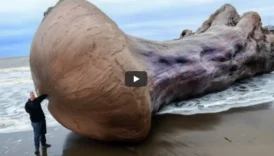The World’s Miraculous and Science-Defying Places

Earth is a treasure trove of astonishing locations that challenge the very rules of science. These sites, often seeming like they’ve leaped out of a fantasy tale, exemplify nature’s boundless power and underscore the uniqueness of our planet.
- The World’s Miraculous and Science-Defying Places
- The Boiling River of the Amazon: A Natural Wonder
- The Mysterious Sargasso Sea: A Boundary-Free Oceanic Marvel
- The Great Blue Hole: A Deep Dive into Mystery
- Death Valley’s Walking Rocks: A Moving Enigma
- Mount Roraima: The Lost World of the Amazon
- The Bioluminescent Waters of the Maldives: A Nighttime Spectacle
- Lake Natron: Nature’s Sculptor
The Boiling River of the Amazon: A Natural Wonder
Deep in the Amazon lies a river that astonishes all who encounter it. Known as the Boiling River, its waters reach temperatures of up to 93 degrees Celsius, hot enough to kill any creature that falls into it. Though it doesn’t literally boil, the geothermal energy driving its heat makes it a singular natural phenomenon.
Scientists have found no other place on Earth quite like this. From small mammals to amphibians, creatures that accidentally fall into the river succumb to its intense heat. This incredible site has become a symbol of the Amazon’s natural mysteries and has been designated as a protected area to preserve its unique ecosystem.
The Mysterious Sargasso Sea: A Boundary-Free Oceanic Marvel
Unlike any other sea in the world, the Sargasso Sea has no land boundaries. Situated within the Atlantic Ocean, it is defined by ocean currents rather than landmasses. Its surface is covered with floating Sargassum seaweed, which provides shelter and sustenance for a diverse array of marine life.
Despite its open-ocean location, the Sargasso Sea is teeming with life. Sea turtles, shrimp, crabs, and various fish species thrive here. Endangered eels migrate to the Sargasso for spawning, making it an essential part of their lifecycle. This unique region highlights the interconnectedness of marine ecosystems and continues to intrigue scientists worldwide.
The Great Blue Hole: A Deep Dive into Mystery
Off the coast of Belize lies the Great Blue Hole, one of the most striking underwater sinkholes in the world. Measuring 300 meters in diameter and 125 meters in depth, this natural wonder captivates both divers and scientists alike. Formed during the Ice Age as a limestone cave, the hole’s deep blue color starkly contrasts with the surrounding turquoise waters.
Recent explorations have revealed intriguing finds at its depths, including remnants of past human activity. The Great Blue Hole is not just a geographical marvel but also a site of historical and ecological significance, attracting adventurers and researchers from around the globe.
Death Valley’s Walking Rocks: A Moving Enigma
In California’s Death Valley, the phenomenon of walking rocks has puzzled scientists for decades. These rocks, some weighing over 300 kilograms, mysteriously move across the desert floor, leaving tracks behind. No one has ever observed the rocks moving directly, but studies suggest that freezing nights and thawing days create thin ice sheets that, combined with strong winds, push the rocks across the terrain.
This natural puzzle is visible only in winter, adding to its intrigue. The enigmatic movement of these rocks challenges perceptions of how seemingly immovable objects can be influenced by subtle environmental factors.
Mount Roraima: The Lost World of the Amazon
Straddling the borders of Brazil and Venezuela, Mount Roraima stands as a testament to nature’s architectural prowess. This flat-topped mountain, made primarily of quartz, rises dramatically above the rainforest canopy. At 2,770 meters, it’s a site of incredible biodiversity, home to plants and animals found nowhere else on Earth.
Its otherworldly appearance and unique ecosystem have inspired both scientific exploration and local legends, making it a living symbol of the Amazon’s untamed beauty.
The Bioluminescent Waters of the Maldives: A Nighttime Spectacle
The shores of the Maldives come alive at night with a breathtaking display of bioluminescence. Tiny plankton emit a neon-blue glow, illuminating the waves as they wash onto the beach. This phenomenon, caused by chemical reactions within the plankton, creates a surreal, otherworldly experience.
Scientists have likened these plankton to natural batteries, as they react to disturbances by releasing light. Visitors lucky enough to witness this rare event often describe it as one of the most magical sights they’ve ever seen.
Lake Natron: Nature’s Sculptor
In northern Tanzania, Lake Natron’s caustic waters are as deadly as they are fascinating. With a pH level that can exceed 12, the lake’s mineral-rich composition calcifies the remains of animals that come into contact with it, effectively turning them into stone statues.
Photographer Nick Brandt captured haunting images of these calcified creatures, drawing attention to this otherworldly site. Despite its harsh environment, the lake’s vivid red and orange hues, caused by salt-loving microorganisms, make it an awe-inspiring destination for scientists and photographers alike.
These miraculous places serve as reminders of Earth’s unparalleled beauty and complexity. Each one tells a unique story, challenging our understanding of nature and inspiring us to explore the mysteries of our planet.
Views: 1





